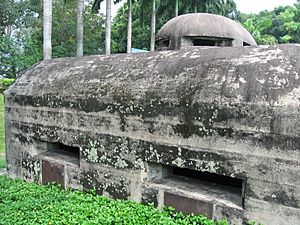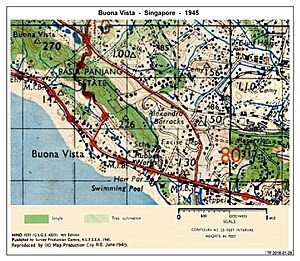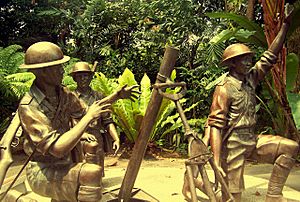Battle of Pasir Panjang facts for kids
Quick facts for kids Battle of Pasir Panjang |
|||||||
|---|---|---|---|---|---|---|---|
| Part of the Battle of Singapore in the Pacific theatre of World War II | |||||||
 Pasir Panjang Pillbox |
|||||||
|
|||||||
| Belligerents | |||||||
| Commanders and leaders | |||||||
| Units involved | |||||||
| Strength | |||||||
| 1,400 infantry | 13,000 infantry | ||||||
| Casualties and losses | |||||||
| 159 killed and hundreds wounded | Hundreds killed and several hundreds more wounded. | ||||||
The Battle of Pasir Panjang was a key part of the Empire of Japan's attack on Singapore during World War II. It happened between February 13 and 15, 1942. This battle was one of the last big fights before Singapore fell to the Japanese.
Japanese forces, about 13,000 strong, landed in northwest Singapore. They began moving south towards Pasir Panjang. These troops were a large part of the 36,000 Japanese soldiers invading Singapore.
Contents
Getting Ready for Battle
The 1st Malaya Infantry Brigade was ready to defend Pasir Panjang Ridge. This group included the British 2nd Loyal Regiment and the 1st Malaya Regiment. They were tasked with protecting an area known as "The Gap." The 44th Indian Brigade was positioned next to them.
A small group of 42 Malay soldiers, led by Second Lieutenant Adnan Saidi, held a very important spot. This spot was at Bukit Chandu, and Adnan's men would soon face a strong Japanese attack.
The Battle Begins
The first clash between the Malay Regiment and Japanese soldiers happened on February 13. The Japanese 18th Division attacked the southwest coast. They moved along Pasir Panjang Ridge and Ayer Rajah Road. The Japanese 56th Infantry Regiment, with strong artillery support, led the attack.
B Company of the Malay Regiment was defending this line. They faced heavy fire from Japanese artillery and tanks. B Company had to pull back. However, the Japanese broke through their position. The soldiers fought in close-up combat, using bayonets. Some from B Company escaped, but others were captured. This breakthrough forced both the 44th Indian and 1st Malay Brigades to retreat. They moved to Mount Echo after dark.
Fighting at Bukit Chandu
On February 14, the Japanese launched another big attack. It started at 8:30 AM with heavy mortar and artillery fire. The 1st Malay Brigade managed to fight off this attack and several others. They suffered many losses, but so did the Japanese. The fighting was very intense, with much close-up combat.
Later that day, another attack, this time with tanks, broke through the left side. The defenders were forced to retreat again. Because other units couldn't hold their ground, the 1st Malay Brigade had to pull back. At this point, C Company of the Malay Regiment moved to a new defense spot at Bukit Chandu.
Bukit Chandu means "Opium Hill" in Malay. An opium factory was located at the bottom of the hill. This hill was a very important defense spot. It was high ground, offering a view of the island. If the Japanese took the hill, they could easily reach the Alexandra area. This area held important British military supplies, hospitals, and other key buildings.
C Company's position was separated from D Company by a large canal. Oil was burning in the canal from a bombed oil depot. This burning oil stopped C Company from retreating further. Second Lieutenant Adnan Bin Saidi led C Company. He told his men to defend Bukit Chandu until the very end. He and many of his soldiers were killed in this final battle.
The Japanese attacked Bukit Chandu again in the afternoon. This time, they tried a trick. Some Japanese soldiers dressed up in captured British Indian uniforms. They tried to pretend they were allied Indian soldiers. But C Company saw through the trick. They knew British soldiers marched in three columns, but these "Punjabi" soldiers were marching in four. When they got close, C Company opened fire. They killed 22 disguised Japanese soldiers and wounded many more.
The Last Stand
Two hours later, the Japanese launched a massive attack. They came in huge numbers, trying to overwhelm the Malay troops. This attack, with artillery and tank support, finally broke the Malay Regiment's defense line. Even though they were greatly outnumbered and running low on ammunition, the Malay Regiment kept fighting. They used bayonets and fought hand-to-hand. Adnan was badly hurt but refused to give up. He kept telling his men to fight to the end.
Soon after, the Pasir Panjang area fell to the Japanese. Adnan, who was severely wounded, was captured. He was killed by the Japanese for his brave resistance.
Who Was Lost
During the entire Malayan Campaign, especially from February 13 to 15, 1942, the Malay Regiment lost 159 soldiers. This included British and Malay officers, and many other soldiers. Many more were wounded. About 600 surviving Malay Regiment soldiers gathered at Keppel Golf Link. They were later taken as prisoners of war. The number of Japanese casualties is not clear.
What Happened Next
The Battle of Pasir Panjang did not change the final outcome for Singapore. It was clear that the British would soon surrender to the Japanese. The Allied units were meant to defend the ridge, but they ended up fighting the main Japanese invasion force.
Bukit Chandu was important because it overlooked the island. It also controlled the path to the Alexandra area. This area had the British army's main ammunition and supply depots, and a military hospital. When Bukit Chandu fell, the Japanese gained access to Alexandra. This indirectly led to the Alexandra Hospital massacre.
Today, Adnan Saidi is remembered as a hero in Singapore and Malaysia. He is honored for encouraging his men to fight bravely and not surrender. School textbooks in both countries mention him as the soldier who spotted the disguised Japanese troops.
Fighting continued even after Adnan's death. The British officially surrendered Singapore to the Empire of Japan on February 15, 1942. Some Malay Regiments continued fighting in areas like Alexandra Hospital, Tanjong Pagar, and Pulau Belakang Mati (Sentosa).
In 2021, Ujang Mormin, the last known survivor of the battle at Pasir Panjang, passed away at 100 years old. He was a private in the Malay Regiment and was 21 when he fought the Japanese.
See also
- History of Singapore
- Battle of Singapore
- Japanese order of battle during the Malayan Campaign
- Malaya Command



